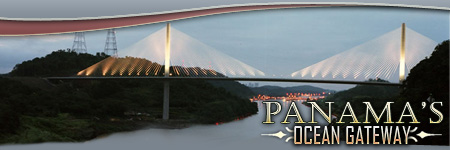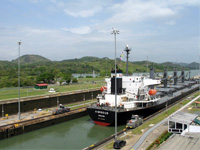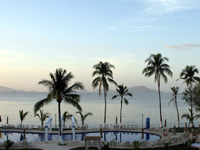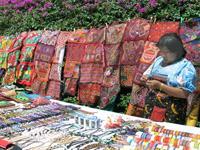|

By Susan McKee
The secrets and story behind the Panama Canal
Standing on the observation terrace of the Visitors Center at the Miraflores Locks, I watched a pair of enormous ships make their way through the tight passage with just inches to spare. Lashed to locomotives to keep them from wavering in the narrow confines of the locks as millions of gallons of water flowed in, the vessels as big as skyscrapers were lifted on their transit from one ocean to the other.
Location is the key to Panama's prosperity. A narrow isthmus connecting Central and South America, this small country is an ancient transit point between the Pacific and Atlantic oceans.
Mule-hauled journeys such as those made by treasure-laden conquistadors in the 16 th century were replaced in 1855 by the Panama Railroad. Trains still cover the 50 miles between Colon and Panama City, but most cargo travels on the waters of the Panama Canal, opened in 1914.
 |
Panama Canel Locks |
It's just not possible to visit Panama without visiting the canal itself, and the Miraflores Visitor Center is the place to do it. Start with the 10-minute video for a good overview. Four exhibit halls explain this complicated set of channels, locks and lakes that provides the tiny country's main economic activity – and its primary watershed, supplying 95% of the drinking water for the inhabitants of four of Panama's largest cities.
Three galleries focus on the canal, its history, operation and economic activity, but my favorite was the Hall of Water. Rainfall in this area is an astonishing 27 feet a year. The canal uses millions upon millions of gallons of the precious liquid, and conservation of the watershed is a primary concern for Panamanians. Perhaps I'm easily amused, but I was mesmerized by the freshwater fish tanks showing the wide variety of piscine life.
Although a dream for centuries, the canal wasn't realized until the early 20th through a complicated tale of failed attempts by several nations, evolving technology and advancing medicine (until the causes of malaria were identified, laborers died in droves). When the U.S.-built canal opened to commercial traffic in 1914, it was strictly an American operation. The Canal Zone was populated by Americans and protected by U.S. soldiers.
The canal has been Panamanian for seven years now (the transition was slow -- President Jimmy Carter signed the treaty to turn over control back in 1977). Despite dire predictions of chaos, it's business as usual, and ships continue to ply its waters for an average transit time of 8 to 10 hours.
Even the casual visitor will notice that the canal is operating at capacity. Sitting on the balcony of my room at the Intercontinental Playa Bonita Resort in the evening, I could see the lights of cargo vessels lined up for miles as they waited to enter the canal from the Pacific Ocean.
In fact, more than 922,000 vessels have used the waterway since its opening. Tolls, dependent on tonnage and other factors, aren’t cheap. Back in May, the Maersk Dellys established a new toll record by paying $249,165.00. The lowest toll was 36 cents, paid by Richard Halliburton who swam the canal in 1928.
Almost 14,000 ships use the canal annually, and the bottlenecks are the pairs of locks at Gatun (on the Atlantic side), Pedro Miguel (midway) and Miraflores (Pacific) – hence the proposal for expansion. The narrowest part of the Canal is Gaillard Cut, stretching from the Pedro Miguel Locks to the southern tip of Gatun Lake (about 8-1/2 miles).
I learned all this at the Miraflores Visitor Center, which also explained that the locks were necessary because Gatun Lake is 26 feet higher than sea level.
New vessels produced in Asian shipyards are too wide for existing locks. Nevertheless, the recent voting on whether to expand the canal was hotly debated. In the end, the Panama Canal Authority’s proposal for expansion won. A third set of new, wider locks will be added to those in operation for almost a century.
The American influence remains. Many military personnel have retired in Panama, fueling a building surge of coop apartment towers in the capital. The American dollar is the preferred currency, and most everyone in the tourist areas speaks English.
 |
Pacific Coast Sunset |
The name "Panama" is said to mean "an abundance of fish and butterflies" in an unspecified indigenous language, and that abundance is in evidence in the former Canal Zone. During the American occupation, it was kept free of development, so the biodiversity of the narrow swath of land on either side of the water is astonishing.
This was my first trip to Panama, and I was surprised to learn that the canal wasn't, well, a canal like, say, the Erie Canal. Because it's an interconnected series of waterways including rivers and lakes, fishing boats, kayaks and other pleasurecraft ply its waters.
The largest urban area is Panama City, on the Pacific Coast. Founded by the Spanish in 1519 adjacent to an indigenous fishing village, it was a key colonial transit point: during the 16th and 17th centuries, with 60 percent of all silver sent to Europe passed through the city. The classic stone buildings of Old Panama still attract tourists, even as the building boom continues in newer parts of the capital city.
Alongside the prosperity of the "new" Panama is the grinding poverty of the "old." Tenement-style concrete apartments house city dwellers not benefiting from the booming economy, and ramshackle huts seem the rule in rural areas. Surprisingly, school is not mandatory for the country's children.
The roads in Panama aren't as easy to travel as the waterways, so trips to the interior are sometimes bone-jarring. It's worth it, though, to see what the country looks like beyond the five-mile-wide Canal Zone. Even the smallest houses have bars on their windows while the walls of the gated estates of the wealthy are topped with razor wire.
 |
Molas at Indian Market |
On the Sunday of my visit, I headed to an indigenous market. Indians from across the country, wearing native dress, gather each week, bringing their handicrafts – including the iconic molas (colorful reverse appliqué designs fashioned into tote bags and pillow covers). There’s a much larger selection here and, because you’re buying from the producers, the prices are about half of what you'd pay in a Panama City souvenir shop.
My market jaunt and other excursions were arranged by the tour desk at the Gamboa Rainforest Resort.
|